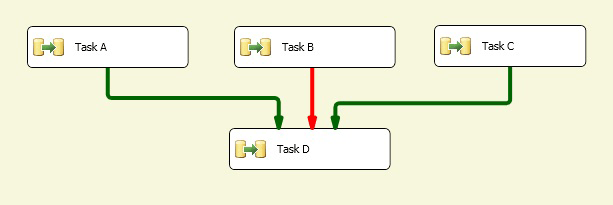Multiple Precedence Constraints
A precedence constraint connects two executables: two tasks, two containers, or one of each. They are known as the precedence executable and the constrained executable. A constrained executable can have multiple precedence constraints. For more information, see Precedence Constraints.
Assembling complex constraint scenarios by grouping constraints enables you to implement complex control flow in packages. For example, in the following illustration, Task D is linked to Task A by a Success constraint, Task D is linked to Task B by a Failure constraint, and Task D is linked to Task C by a Success constraint. The precedence constraints between Task D and Task A, between Task D and Task B, and between Task D and Task C participate in a logical and relationship. Therefore, for Task D to run, Task A must run successfully, Task B must fail, and Task C must run successfully.

LogicalAnd Property
If a task or a container has multiple constraints, the LogicalAnd property specifies whether a precedence constraint is evaluated singly or in concert with other constraints.
You can set the LogicalAnd property using the Precedence Constraint Editor in SSIS Designer, or in the Properties window that SQL Server Data Tools (SSDT) provides.